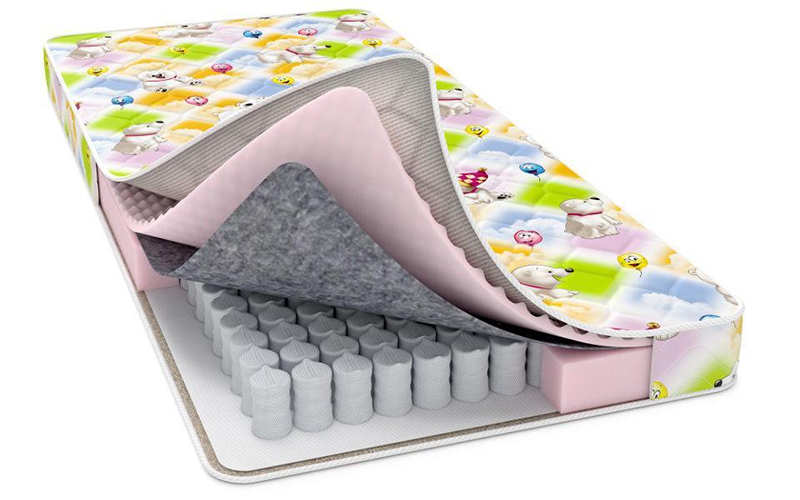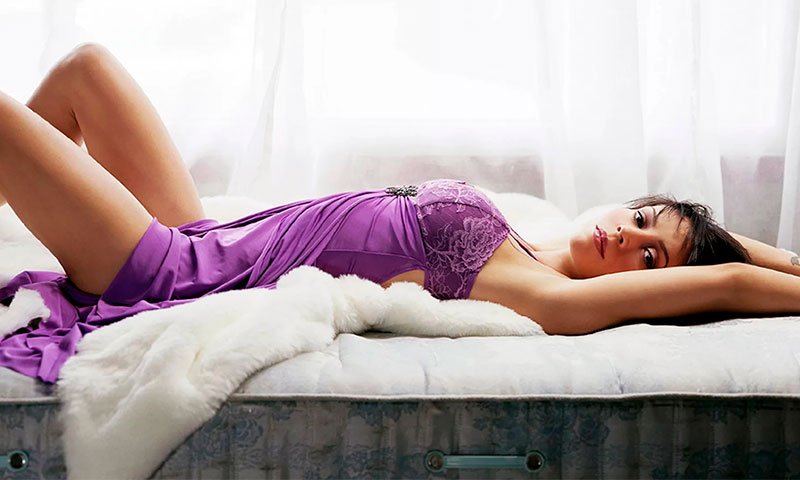Is your family expected to grow, and are you preparing a baby cot? Or has the child already grown up, and it's time to buy new furniture and bedding appropriate for age in his room? In any case, without a good children's mattress is not enough. His choice should be approached more carefully than the purchase of adult models - after all, the spine is not strong enough for children, and the wrong bed can easily ruin the posture. And this will entail other health problems. In order not to risk, listen to the advice of our specialists before heading to the store for such a serious purchase.

Content:
The best manufacturers of children's mattresses - which company to choose
If you are looking for a really high-quality and durable mattress for your child, pay attention to the products of the following companies:
- Ormatek;
- Ascona;
- Plitex;
- Dream Line;
- Vegas;
- Lineaflex.
In their assortment there are whole lines addressed to children of different ages. We recently reviewed the very best models from these manufacturers in our baby mattress rating.
You can simply choose the cutest model among them. Or to approach the issue of choice with all responsibility and to study in detail the requirements that a good children's mattress should meet.
Device mattresses for children

The structure of modern mattresses differs from its predecessors in its layering and variety of materials used for stuffing.
The number of components may be different, but there are three main parts for any mattress:
1. The basis - springs (dependent or independent) or dense fillers from plant fibers, polymers, latex, etc. They perform the main function - they support the body in the correct position during sleep.
2. The layer is often used in spring models for a more even distribution of the load and reduction of the wire pressure on the body. But in frameless mattresses there is an additional top layer made of a different material. It depends on him how comfortable your child’s sleep will be.
3. The cover is an outer shell that protects the mattress from damage and dust accumulation, as well as gives the product an aesthetic look.
Types of children's mattresses
Spring with dependent block bonnel

The basis of these mattresses are metal springs, connected to each other with wire. Such products are inexpensive, but do not give a serious orthopedic effect.
Another drawback of such models is considered to be the sagging of the springs in the manner of a hammock, but with a small weight of the child and sufficient rigidity of the dependent block, it is hardly worth fear.
Pros:
- They calmly withstand high loads - important for those whose children love to jump on the bed;
- Good thermoregulation and free air circulation inside;
- Moderate orthopedic effect;
- Affordable price.
Minuses:
- Over time, the connecting springs stretch and the frame sags;
- They can creak;
- Not suitable for the smallest.
Spring on independent blocks

Here at the base of the mattress are hundreds of vertical springs - isolated from each other and placed in individual cases. Each spiral works by itself and does not help its neighbors.
As a result, a good orthopedic effect is created, where all parts of the body are supported by separate springs - without dropping and sagging in the center.
Pros:
- Ideal from the point of view of orthopedists;
- Provide the necessary support to the spine;
- Do not sag and serve really long;
- Suitable for children from three years.
Minuses:
- High price;
- Low breathability.
Springless

These mattresses are considered the best for children. They are made of high quality artificial or natural fillers, usually characterized by increased rigidity and therefore suitable even for newborns.
There is no frame as such, but the body load is distributed evenly, ensuring the correct position of the head, cervical and spinal parts of the baby’s spine.
Pros:
- Low weight;
- You can choose any degree of stiffness;
- Suitable for children from birth;
- Made exclusively from hypoallergenic materials;
- Well absorb moisture and at the same time practically do not collect dust.
Minuses:
- High price;
- Poor-quality products can be dangerous if, when gluing layers of packings, the manufacturer used a harmful compound.
Options for choosing a children's mattress

Dimensions
Having decided on the view, go on to find the right size of children's mattress. It should easily fit in the crib (otherwise the appearance of bumps can not be avoided), but do not hang inside - the maximum allowable gap between its edges and the edge of the bed is 4 cm.
Most of the children's furniture is made according to certain standards, which are used by manufacturers of bedding. The most common mattress sizes for the smallest are: 120x60, 125x65 and 140x70 cm.
Thickness also matters, especially if it is a frameless model. The “more powerful” the chosen mattress, the more weight it can bear.
1. Newborn babies and children up to 3 years old will be enough thickness from 5 to 12 cm;
2. Children 3-7 years old need to look for a model with a height of 10-15 cm;
3. Adolescents over 12 are already taking adult sizes (15-20 cm).
Fillers
When choosing a children's mattress, one of the most important factors is the material of the filler and the upper layer. They require environmental friendliness, hypoallergenicity, long service life, good moisture absorption and breathability.
The presence of certain orthopedic properties is welcome. In general, almost all materials used in the production of mattresses for children possess these qualities. Just some of them are more pronounced.
1. Coconut fiber (coir)
Natural filler with antibacterial properties and also does not cause allergies. This material is quite elastic and at the same time has optimum stiffness, which allows it to evenly distribute the load on the surface.
Loose weave of fibers provides effective removal of moisture without its accumulation inside and maximum ventilation. Also, coconut coir has the property of thermoregulation, that is, in winter, the child will not freeze on such a mattress, and will not sweat in summer.
In general, this is an ideal option - from which side you look. And it is great for children of any age, from the first days of life.
2. Latex
In the production of children's mattresses can be used both natural and cheaper artificial latex. Both materials have medium stiffness and excellent elasticity, so they are used not only for the main packing, but also as a layer on top of the spring blocks.
As a result, children's mattresses acquire anatomical properties, that is, they are able to repeat all the bends of a child’s body, providing uniform and soft support. Latex is an environmentally friendly and hypoallergenic product with good thermoregulation and long service life.
3. Polyurethane foam
Attempts by manufacturers to find a cheaper alternative to expensive latex led them to polyurethane foam (PPU) - an improved version of foam rubber. It possesses properties similar to latex, but its service life is much less.
4. Streamfiber
Another good material from the foam rubber family with vertically arranged fibers.Despite his artificial origin, he is able to keep warm, well passes air and has sufficient elasticity to provide reliable support to the children's spine.
5. Felt
Wool nonwoven fabric: soft, warm, even healing in its own way. But for children with allergies such a mattress should not be bought in order not to provoke a reaction. Felt cannot boast of good elasticity, therefore it is used exclusively as an intermediate layer between the spring block and the cover.
Fillers of seaweed, buckwheat husk and other "exotic" also show themselves well in operation, but they are less common, costly and may lose shape over time.
Whether you need to spend money on them - decide for yourself. But the list of materials, which in no case should not be in the children's mattress, it is better to memorize.
These include:
1. Normal foam - too short-lived;
2. Cotton wool - is lumped together, accumulates moisture inside and starts to rot;
3. Memory Foam - badly passes air.
Child's age
This factor is not connected with the weight of the growing children, as many parents think, but with the peculiarities of the development of his body. A newborn baby has soft cartilaginous bones, and the formation of its skeleton lasts several years.
During this period, the high rigidity of the surface on which the baby will sleep is especially important. Only she will provide the necessary support for the spine. The main rule: the smaller the child, the harder he needs a mattress.
Case
This part should be made only from natural, breathable materials: flax, cotton, dense jacquard. It is desirable that the cover was removable, then you can easily remove it and wash it in a typewriter.
Which baby mattress to choose

1. A newborn child is better to choose springless mattress with a hard pad of coir or seaweed. These natural materials not only guarantee maximum support for the spine, but also help the crumbs to strengthen the immune system, relieve allergies and even reduce the risk of diaper rash. The height of the mattress should be within 5-10 cm, the cover must be removable, even if the baby is sleeping in diapers.
2. Children from one year to three years old can already take something softer, for example, the same coir, but with an additional layer of latex or polyurethane foam. Combined mattresses are perfectly restored after deformation due to the elastic layer, but still provide adequate support for the child's skeleton. The optimum thickness is 8-12 cm.
3. Doshkolat at the age of 3-7 years could continue to use a combined mattress, if not for their intensive growth, requiring a complete replacement of the bed. They are also suitable for spring models of bonnel, preferably with different stiffness: for example, with coconut coir on the one hand and polyurethane foam or struttofiber on the other. The total thickness can range from 10 to 15 cm.
4. For children from 7 to 12 years, choose spring mattresses on independent blocks of medium hardness with a layer of latex or any improved version of foam rubber. However, here you will have to take into account the formed posture, so before buying a particular model, consult with the orthopedic surgeon.
Adolescents are already equal to adults, so that they will have to pick up bedding, taking into account the complexion and lifestyle:
1. Those who have problems with posture, we need very hard mattresses based on coir.
2. Independent spring blocks will be suitable for well-fed or simply large teenagers.
3. If a child grows too fast and suffers from IRD, it is better to take him a mattress with a latex layer to prevent blood vessels from squeezing.
How much are mattresses for children

1. Springless mattress can be purchased at a price of 700 rubles. The most expensive imported models can reach up to 62-64 thousand.
2. The minimum cost of children's models on dependent bonnel springs is 850-1100 rubles, the maximum is about 10-11 thousand rubles.
3. Products based on independent springs start from 1500 rubles, the ceiling for them is 25-30 thousand.
It will be interesting to friends too










